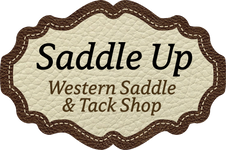Saddle Series: The Western Saddle, Part 1
Posted by Saddle Up on May 15th 2014
Although the Western saddle has evolved into several different styles of saddles, barrel, roping, trail, etc.. the parts of the saddle remain the same. Here's a reference-able explanation of the points of the saddle as it's always a good idea to brush up on saddle terminology!

(photo taken from Equusite)
Horn: This part of the saddle needs no introduction. It's one of the signature features of a Western saddle. Originally it was designed for roping, but as the various disciplines have developed it has become a decoration and/or a functional support. Modern day ranchers and team ropers still use it for its original purpose, while barrel racers use it to grab and go. When used saddles come into the shop the horn always helps assist us in determining what kind of discipline the saddle is.

(photo taken from Dreamstime)
Swell: The swell is the part of the saddle that holds the bars together and supports the horn.
1. A-Fork - A-forks were very popular on ranch saddles back in the day. They are still a very widely used style on today's working ranch saddles. Because of the shape of the swell, working cowboys like them because they don't get in the way of their work. Some folks ad bucking rolls to give them a soft stop when catching cattle.

(photo and references taken from The Horse Saddle Shop)
2. Swell Fork - As Western competition/pleasure riding became more popular and widespread and the disciplines began morphing into what they are today, most saddles began being built with swell forks, for safety reasons. This is the type of swell you will most likely see on saddles these days.

(photo and references taken from The Horse Saddle Shop)
3. Undercut Swell, also known as a Bear Trap - Rarely if ever do you see an undercut swell on a new saddle. The reason for this type of swell was for "breaking wild horses". The swell helped keep you locked into the saddle and provided more to hold on to during dangerous situations. However it has been proven that sometimes it is safer to fall off than to stay on.

(photo and references taken from The Horse Saddle Shop)
Seat: The seat of a saddle can be deep, flat, padded, smooth, suede, rough-out, sit you in a pocket, or sit you forward. It all depends on the saddle and what discipline it was built for. The comfort of the seat depends on the personal opinion of the individual. Seat sizes range from 10" to 18". You usually measure the seat from the middle of the swell to the edge of the finished seat.

(photo by Saddle Up)

(photo by Saddle Up)
Cantle: The cantle keeps you from sliding off the back of the horse and depending on the angle whether high, medium, or low will have a hand in how the saddle sits you. Barrel saddles tend to have a higher cantle, whereas show saddles have a lower cantle. Ranch saddles not only have different cantle heights but also different styles.

(photo taken from About the Horse)
Make sure to check out next week's blog, The Western Saddle, Part 2 as we continue going through the points of the saddle!
"Feeling down? Saddle up. " --Author Unknown
~Saddle Up
